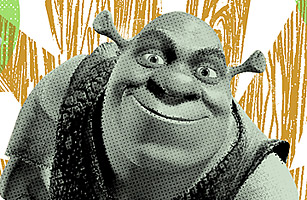
Say "animated feature," and most filmgoers of the past decade instantly think of Pixar. Finding Nemo, WALL•E, Up and Toy Story 3 are among the most impressive achievements, animated or otherwise, of this young movie millennium. But the most influential studio in a format that outstrips the live-action film in imagination, skill and box-office appeal has to be Jeffrey Katzenberg's DreamWorks Animation. And the movie that defines the DreamWorks decade is 2001's Shrek.
Think of the two companies as the Beatles and the Rolling Stones. The Fab Four created the richer, more enduring body of work, à la Pixar, but it was the Stones whose gritty rock and outlaw image have been imitated ever since. Similarly, the DreamWorks gestalt — impish, parodic, brimful with pop-culture references — has infiltrated animated films from Ice Age to Despicable Me and plenty more.
Katzenberg ran Disney's animated (and live-action) films for CEO Michael Eisner before bolting from the Magic Kingdom in 1994; with Steven Spielberg and David Geffen, he founded DreamWorks the same year. Katzenberg's original notion of DreamWorks animation was close to the Disney model he had helped establish with The Lion King ($784 million worldwide gross) and its immediate successors, Pocahontas and The Hunchback of Notre Dame: soaring, serious musical dramas of the sort that dominated Broadway for two decades.
At DreamWorks, Katzenberg opened by dreaming big, Disney-style, with the 1998 biblical musical The Prince of Egypt — wags called it The Zion King — animated in the traditional hand-drawn way. But he also set up a CGI unit, a Pixar on the cheap, with Pacific Data Images. Their first film, Antz, with Woody Allen as a neurotic bug leading an insect insurrection, set the capering tone that would reach full flower with Shrek.
Fashioned by an army of writers, directors and animators under Katzenberg's acute eye, Shrek took the serious animated musical and farted in its general direction. As Mel Brooks' The Producers (another 2001 smash) reminded Broadway that there's nothing so buoyant as a musical comedy, Shrek showed the movie industry that animated feature is just a fussy phrase for cartoon. Less indebted to the classic Disney format than to Warner Bros. cartoons and the Rocky and Bullwinkle TV shows, Shrek implanted the idea of cartoon figures not as themselves but as actors playing characters. Disney and Pixar films create self-contained worlds; DreamWorks films were, and are, sketches of the Saturday Night Live stripe — but funny.
Based on William Steig's smart-kids' story, Shrek became a deconstruction of all things Disney. The movie cited and mocked Pinocchio, Cinderella, The Three Little Pigs and Robin Hood. When seven dwarfs lug a comatose Snow White into Shrek's kitchen, the ogre (Mike Myers) insists, "Oh, no no no no. Dead broad off the table!" And please, no fancy musical numbers. When Shrek's sidekick Donkey (Eddie Murphy) launches into a little aria, the big guy shouts, "Stop singing!"
While Disney's hand-drawn-animation unit stumbled on for a few years before the company mothballed the format and bought Pixar, DreamWorks went fully CGI and totally Shrek-ish. Hits poured out of the studio at a frantic rate, two or three a year: not just three Shrek sequels (which have topped the Toy Story trio with $2.5 billion in theatrical revenue) but also Madagascar, Kung Fu Panda and the current Megamind. Katzenberg, a full-service showman, was also an early zealot for 3-D, which gives his films extra pop off the screen and at the box office.
Rivals have followed DreamWorks' lead — not Pixar's. Today's typical animated feature is a bright, brisk vaudeville that makes fun of everything, including itself. And for the multibillion-dollar animation industry, that's something to sing about.